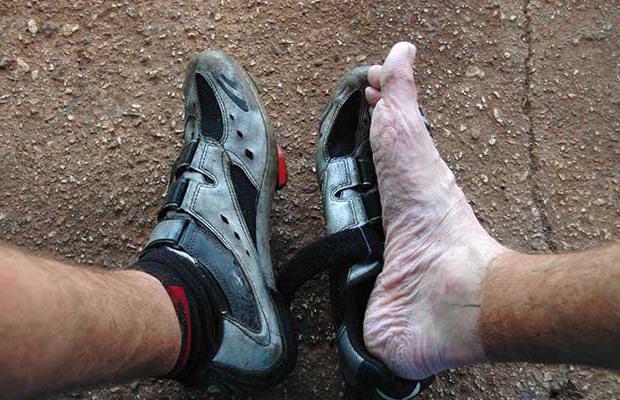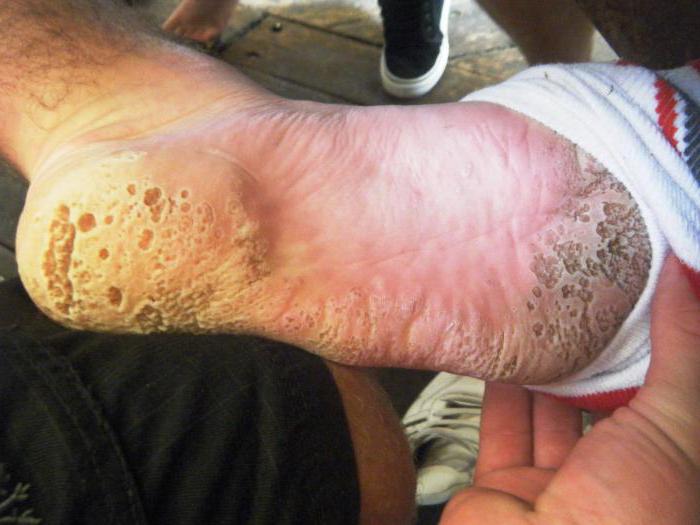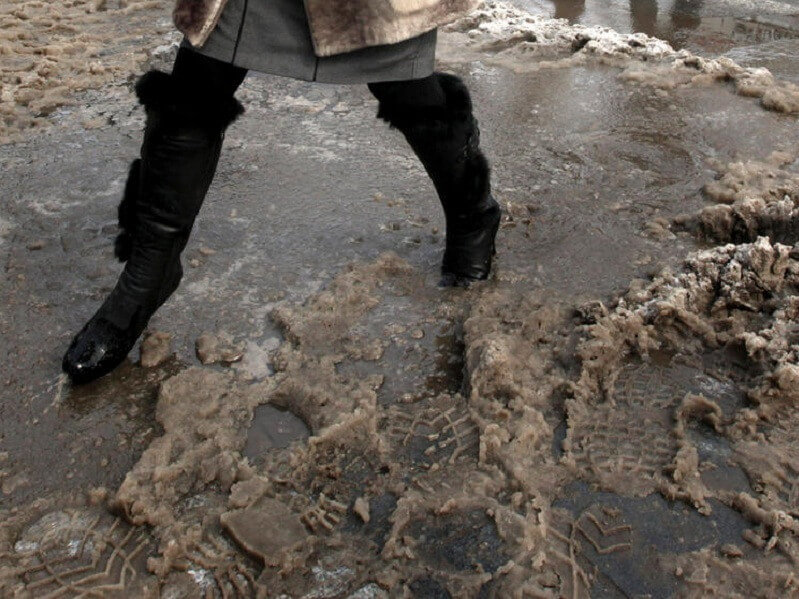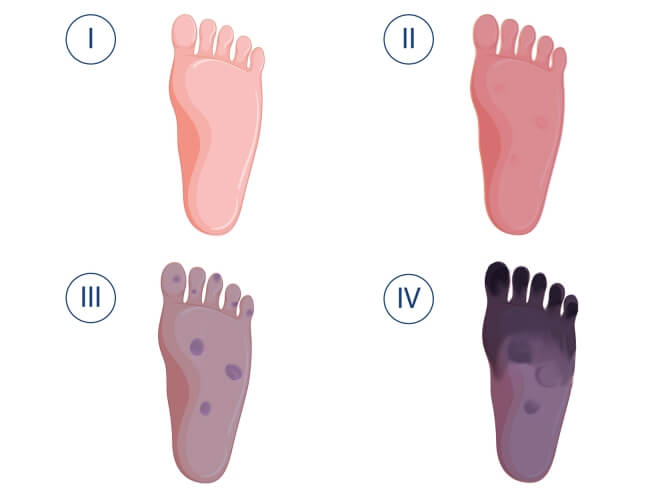While this classification is widely used, it has limitations because it relies on symptoms that occur after frostbite and does not allow an assessment of the degree of tissue involvement in the pre-frostbite (pre-thaw) period. This classification is often presented in a simplified form, distinguishing between superficial frostbite (grades 1-2) and deep frostbite (grades 3-4).

- Photo Trench foot.
- ditch foot
- Caused
- Etiology of the development of trench foot syndrome.
- Pathogenesis of the foot ditch.
- causes
- pathogenesis
- treatment and prognosis
- How to recognize the disease - description of the clinical picture
- Stages and degrees of severity of the disease
- Who is at risk of 'frostbite without frostbite'?
- How is the trench foot treated?
- causes
- Classification and clinical manifestations.
- frostbite
- Freeze
Photo Trench foot.
ditch foot
Trench foot is a foot condition that develops with prolonged wearing of tight, wet footwear in cold temperatures. The risk of contracting it is particularly high when you are in a predicament where you cannot move your feet. The disease is a lesion of the skin, subcutaneous tissue and nerve tissue, and the symptoms vary in severity. It is a form of frostbite and can occur not only on the feet but also on the hands.
Caused
The main cause of the trench foot is the effects of low temperatures and high humidity. As a result of this reaction, the skin of the feet becomes ulcerated and gradually loses sensitivity. If these changes are not noticed and treated in time, the nerve fibers become inflamed and irreversibly damaged.
The disease owes its name to the fact that it was first described during the war (trench foot). Soldiers who had to spend long periods in the trenches in wet boots without being able to change them often suffered from skin sores and loss of sensitivity. Similar symptoms also appeared in people who worked in the trenches.
However, the manifestation of the disease is not tied to professional activity. The pathology can appear in anyone who is outdoors in cold and wet footwear. Since the mechanism of the disease is related to the immobilization of the foot and toes, tight footwear is the most dangerous.
Etiology of the development of trench foot syndrome.
The main etiological factors of development are:
- Moisture and its constant or prolonged contact with the skin of the foot. Moisture is the main etiological factor that significantly reduces the heat insulating function of shoes;
- Low but not sub-zero temperatures. The syndrome occurs most often at temperatures between +2 degrees Celsius and +10 degrees Celsius. Cases have become known in which the following symptoms, among others, have developed 'Moat Foot' at temperatures between +12 and +14 degrees.
- Lack of mobility. Inadequate mobility leads to reduced blood circulation in the tissue and consequently to a reduction in the skin barrier and an increase in exposure to cold.
Pathogenesis of the foot ditch.
A drop in temperature and prolonged exposure of the skin to low temperatures leads to permanent contraction of smooth muscle fibers in the vascular wall. This contraction then intensifies and spreads to larger radius capillaries and then to arterioles and veins.
As a result, blood flow decreases, leading to increased coagulation and microthrombosis.
Metabolism in the affected tissues slows down, and hypoxic tissue damage (circulatory hypoxia) and trophic disorders (skin lesions, blisters, necrosis in severe stages) occur.
Stress and overexertion seen in soldiers also contribute to the decline in immunity.
causes
Trench foot occurs when soldiers are in high humidity combined with low, but not sub-zero, temperatures for long periods of time. Increased humidity plays a crucial role as it affects the thermal insulation properties of clothing and contributes to the soaking of footwear. Damage often occurs at temperatures between +5°C and +10°C. A temperature drop between +2°C and +5°C can provoke a severe form of the disease, leading to necrosis.
Lack of mobility is another important factor. In military personnel, the disease occurs more often after a long stay in the trenches in early spring or late autumn. A similar condition known as immersion foot occurs when sufferers lie in cold water for long periods of time following shipwrecks, minor shipwrecks, floods, and other water-related events.
In times of peace, fishermen, skiers, mountaineers and hikers who undertake multi-day hikes suffer from the ditch foot. If the above conditions coincide, the disease can also occur with regular foot warming. Low temperatures and frosts are considered unfavorable conditions for the occurrence of the disease - in such cases one speaks of frostbite rather than ditch feet.
pathogenesis
A decrease in tissue temperature leads to an increase in the tension of the smooth muscle fibers in the vessel wall. There is persistent vasoconstriction. This leads to an impairment of blood flow, first in the capillary network and then at the level of the smaller arteries and veins. If the temperature drops further, the blood in the vessels thickens and stops moving. The components clump together and blood clots form.
The metabolic processes in the cells are first activated and then slowed down. Persistent low temperatures lead to a hypoxic cycle, which causes trophic disorders of varying degrees of severity, up to and including necrosis, and contributes to secondary inflammation. Edema is caused by leakage of fluid from the vessels into the tissue and local acidosis. The peripheral nerves are particularly affected in trench foot - the combination of cold and impaired blood flow leads to degeneration of the myelin sheaths and subsequent neuropathy.
treatment and prognosis
Treatment is conservative. It consists in resting and relieving the limbs, immobilizing them for a period of 3 to 4 weeks and prescribing physiotherapy treatments, massages and exercise therapy.
Prevention consists of close medical supervision of the recruits (treatment of flat feet) and the wearing of well-chosen, sensible shoes.
References: Kramarenko GN Pathological displacement of the metatarsal bones due to excessive loading, Orthop. and Traumatology, No. 1, p. 60, 1971; Reinberg SA Radiodiagnosis of bone and joint diseases, vol. 2, p. 107, M., 1964; Deutschlander C. about inflammatory metatarsal tumors, Arch. clin. Chir., Vol. 118, p. 530, 1921, Bibliogr.; Ziesсhe HW Clinic and X-ray of March Fractures, Z. Militarmed., Vol. 8, p. 289, 1967.
C. S. Tkachenko; GA Zedgenidze, SA Reinberg (r.).
How to recognize the disease - description of the clinical picture
The disease primarily affects the arteries and disruption of normal blood flow in them. Cold feet and prolonged stay in humid environment are the first cause of this traumatic condition. The first symptoms are very vague and it is difficult to recognize the severity of the disease at an early stage. Initially, a vague pain is felt in the feet and the muscles are visibly weakened. The feet are visibly swollen. The color of the skin changes and becomes blue. At the onset of the disease, the skin on the feet is slightly discolored, pale, clammy to the touch, and cold. The pulse is palpable but weak and barely perceptible. With this injury, the course of the disease has a clear sequence. First the nerves and muscles react to the cold and wet, only then do the external signs of the disease appear on the skin.
Patients with this diagnosis report temporary numbness in the legs and pain when trying to rub the skin. This is particularly uncomfortable at night.
Trenchfoot is a disease that can affect not only the lower but also the upper limbs.
If the disease is neglected and left untreated, the consequences can be tragic. However, as a rule, as soon as external symptoms are detected and pain of an unknown nature appears, accompanied by weakness of muscle tissue, patients seek help.

Stages and degrees of severity of the disease
Doctors speak of four stages of frostbite. The first stage occurs within a few weeks if you regularly wear wet shoes in cold weather. It is not uncommon for the first degree to appear as early as the third day after wearing cold and wet shoes. At the beginning of the disease there is spontaneous pain in both limbs. These are particularly noticeable in the toes. Patients have difficulty walking and try to walk on their heels only. The feet gradually lose their sensitivity. Lack of response to the Achilles tendon reflex when tested with a medical hammer. Muscle weakness at this stage is not due to arterial lesions.
The first stage is followed shortly thereafter by the second stage. Trench foot is accompanied by severe swelling of the feet. The skin on the toes begins to turn red. The redness can extend to the area of the calf muscles.
Patients presenting for treatment with primary and secondary symptoms of injury are treated safely.
Patients with stage 3 injuries are rare. This is because no one waits until it gets worse and sees a doctor in time. In stage 3, blisters form on the skin that may ooze dark fluid. These burst and form a thick scab. This necrotic phenomenon can spread far and deep. Over time, the scabs turn into uncomfortable boils that are very difficult and time-consuming to treat.
Stage 4 is considered the most difficult and dangerous. The skin tissue is severely attacked and severe necrosis occurs. As a result, anaerobic infection occurs and gangrene develops. In this case, there is no way to save the victim's feet and legs.

Who is at risk of 'frostbite without frostbite'?
Is it possible to contract this disease even without being a fisherman or an avid traveler? Yes, you can, for the following reasons.
We all think that frostbite can only occur in sub-zero temperatures. However, there are cases when the disease appeared at 14-16 degrees Celsius!
In 1998, during the Glastonbury Music Festival in June, doctors saw about 90 patients with trench foot syndrome every day.
In the big city in autumn and spring it is enough to walk a few hours in damp shoes if the outside temperature is below +8 degrees Celsius.
By the way, standing for a long time leads to blood congestion in the legs, swollen feet and a deterioration in blood circulation. Anyone who lives in the capital knows that! Long subway rides (standing on your feet and not being able to change position), tight shoes, muddy streets, etc. Stress and overexertion also contribute to the general decline in the body's immunity.

The first symptoms are very vague; not everyone notices them at all. At the onset of the disease, the skin on the feet is slightly discolored, pale, clammy to the touch, and cold. People themselves report temporary numbness in their feet and pain, especially in their toes, and tingling or twitching when they try to rub their skin. This can last for days, and if you continue to regularly wear wet shoes in cold weather, the condition can progress. Patients have difficulty walking and try to walk on their heels only. Feet gradually lose sensitivity from the tips of the toes.

Stage II follows shortly after Stage I. The feet swell and the skin first turns blue, then red from the tips of the toes and upwards. At this stage, as a rule, everyone sees a doctor and is cured.
How is the trench foot treated?
Treatment at home is possible in the first and second stages.
- First, the feet should be gently warmed, but without the use of electrical or heating devices. Vodka compresses can be applied.
- Take medications that have a pain-relieving effect.
- If you notice that it is getting worse: the pain does not go away, the feet are cold and the color is irregular, you need to see a doctor immediately.
- If blisters form on the skin and burst, this is another important reason to see a doctor.
causes
- Previous cold injuries;
- immobility and uncomfortable posture for a long time;
- Wet or tight shoes and clothing;
- Hunger;
- Excessive physical exertion;
- decreased body's defenses
- chronic cardiovascular and vascular diseases of the lower limbs;
- sweaty feet;
- Serious injuries with loss of blood.
At an air temperature below -10 ºC, frostbite occurs because the cold acts directly on the skin tissue. Most frostbite occurs in air temperatures between -10ºC and -20ºC. This causes small blood vessels to narrow, slowing blood flow and inhibiting tissue enzymes. Finger and toe frostbite are the most common.
- Meteorological Conditions. Increased humidity – the higher the humidity, the greater the thermal conductivity of skin, air, clothing and snow. Dry air is a poor conductor of heat. Wind – heat transfer in the surrounding air is much slower at rest than in the wind.
- Factors that mechanically block blood circulation, e.g. B. tight or compressive clothing or tight-fitting shoes.
- Factors that reduce local tissue resistance: previous frostbite, immobility and excessive bending of the limbs, paralysis of the limbs, vascular diseases of the limbs, trophic changes in the limbs.
- Factors that reduce overall immunity:
- At -30 °C and below, and in contact freezes, the direct action of the low temperatures on the tissues is important, leading to freezing and cell death.
- In this case, there is first extracellular, and then intracellular crystallization, accompanied by precipitation of lipoproteins, disruption of the colloidal structure of proteins, mucoproteins and denaturation of proteins, that is, irreversible effects.
Classification and clinical manifestations.
The first symptom of frostbite is the appearance of pallor in the affected area, accompanied by increasing pain and tingling. The pain initially increases in intensity, but gradually subsides with further exposure to cold. The affected area becomes numb and there is a loss of sensation. When limbs are affected, their function is impaired. For example, if you have frostbite on your fingers, you can no longer move them. The skin becomes hard and cold. The color of the skin also indicates frostbite. It turns bluish, yellow, or white with a deadly waxy coating.
Classically, four degrees of frostbite are distinguished worldwide, which depend on the depth of the tissue damage:

grade 1. Characterized by redness, numbness of the skin and swelling. Tissue damage is limited to the epidermis. Tissue death does not occur. Possible residual detachment of dry epidermis. Burning and stabbing pains, numbness in the frozen area, swelling of the skin with a marbled pattern. When heated, the skin changes color from pale to red, slight swelling and scaling may occur. However, full recovery occurs after a few days.

Grade II It is characterized by the formation of blisters with clear contents, around which redness and swelling develop. Patients complain of itching, burning and blistering of the skin in the first two days. The frostbite continues to be very painful and the swelling extends beyond the affected area. Complete healing usually occurs within 3-4 weeks.

grade 3. Deeper tissue damage leads to blisters with hemorrhagic (bloody) contents as a result of damage to the terminal vessels of the dermis and the underlying plexus (Figure 8). The patient suffers from unbearable, long-lasting pain. The skin around the lesion turns purple. Blisters are rare and swelling is significant and extends beyond the broken skin. All symptoms of sensitization are absent. The skin and subcutaneous fat die off. The dead tissue turns black and separates from the living tissue where purulent lesions appear. The resulting tissue defect heals within 40-60 days due to secondary tissue tension.
frostbite
Frostbite is the mildest form of cold injury Overview of Cold Injuries Exposure to cold can result in a drop in body temperature (hypothermia) and focal soft tissue injury. Non-freezing tissue injuries include cold spasm and trench foot. Read more . The affected areas become numb, swollen, and congested. The treatment consists of heating, which is accompanied by pain and itching. In rare cases, mild hypersensitivity to cold persists for months or years without damaging the underlying tissue.
Prolonged exposure to cold in humid conditions can lead to the development of a foot pit. Peripheral nerves and blood vessels are usually affected; in severe cases, muscle and skin damage can also occur.
Initially, the foot is pale, swollen, numb, cold, and clammy. Maceration of the foot tissues can develop in patients who walk a lot. The maceration causes skin redness, pain and often hypersensitivity to light touches, which can last for 6-10 weeks. The skin may fester and form a black scab. As a rule, autonomic dysfunction develops, which is manifested by increased or decreased sweating, vasomotor changes, and local hypersensitivity to temperature changes. Muscle wasting, dysesthesia, or anesthesia also occur, which can become chronic over time.
Foot pits can be prevented by wearing loose-fitting footwear, keeping feet and shoes dry, and changing socks frequently.
Immediate treatment consists of warming the feet in warm water (37-40 °C) and applying sterile bandages. Nicotine consumption should be avoided. Chronic neuropathy is difficult to treat and amitriptyline can be tried (see Neuropathic Pain: Treatment Neuropathic pain is caused by damage or dysfunction of the peripheral or central nervous system and not by stimulation of pain receptors. Neuropathic pain should be considered , if. Read More ).
Freeze
Freezing is the mildest form of cold injury Overview of Cold Injuries Exposure to cold can result in a drop in body temperature (hypothermia) and focal soft tissue injury. Non-freezing tissue injuries include cold spasms, trench foot. Read more about . The affected areas become numb, swollen, and congested. The treatment consists of heating, which is accompanied by pain and itching. In rare cases, mild hypersensitivity to cold persists for months or years without damaging the underlying tissue.
Prolonged exposure to cold in humid conditions can lead to the development of a foot pit. Peripheral nerves and blood vessels are usually damaged; in severe cases, muscle and skin damage can also occur.
Initially, the foot is pale, swollen, numb, cold, and clammy. Maceration of the foot tissues can develop in patients who walk a lot. The maceration causes skin redness, pain and often hypersensitivity to light touches, which can last 6-10 weeks. The skin may fester and form a black scab. As a rule, autonomic dysfunction develops, which is manifested by increased or decreased sweating, vasomotor changes, and local hypersensitivity to temperature changes. Muscle wasting, dysesthesia, or anesthesia also occur, which can become chronic over time.
The development of a pit can be prevented by wearing loose-fitting footwear, keeping feet and shoes dry, and changing socks frequently.
Immediate treatment consists of warming the feet in warm water (37-40°C) and then applying a sterile bandage. Nicotine consumption should be avoided. Chronic neuropathy is difficult to treat and amitriptyline can be tried (see Neuropathic Pain: Treatment Neuropathic pain is caused by damage or dysfunction of the peripheral or central nervous system and not by stimulation of pain receptors. Neuropathic pain should be considered when if. Read More ).
Read more:- rams on the legs.
- Photo: Diabetic heels.
- Photo of the right leg.
- Photo of scraped feet.
- Photo of the elbow on the foot.
- Photo of the ankle.
- X-shaped legs photo.
- The pubic ligament where it is located Photo.
